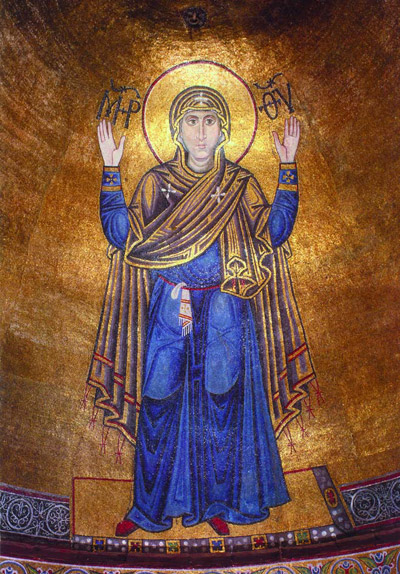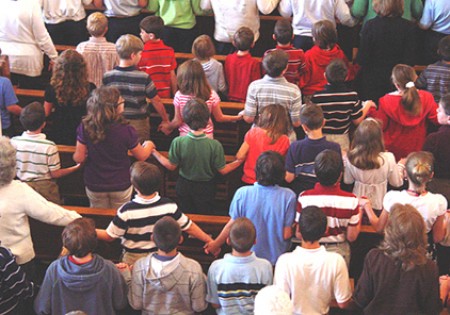 Virgin Orans, a Russian icon called The Great Panagia (All-hallowed). This image of Mary may be found at St. Sophia Cathedral in Kiev, Russia.
Virgin Orans, a Russian icon called The Great Panagia (All-hallowed). This image of Mary may be found at St. Sophia Cathedral in Kiev, Russia.
How does your community pray The Lord's Prayer?
Do the people know one or more settings or a sung version of the prayer that they sing on Sundays and solemnities? If you've just arrived as the new pastoral musician in a parish that only recites The Lord's Prayer, consider introducing the chant from the Roman Missal as your first setting of that prayer.
The chant is easily sung by everyone and can be sung in the same time it takes to recite the prayer. After a year (or maybe two) of singing the prayer every Sunday, introduce a new setting so that you can alternate between them during different liturgical seasons. Make sure that you have notated copies in the pew for your people as a courtesy. Rehearse them before Mass begins; you may want to continue to rehearse the new setting for about a month until you're sure that everyone is familiar with the prayer.
Remember to tell your community why the sung prayer is preferable to the recited version. The way we celebrate liturgy identifies who we are as a community. Music unites people in body and soul. When a parish sings well together, that is to say with its whole heart and soul involved in the musical prayer at its disposal, prayer generates a corporate channel of grace beyond what the spoken word can do. A healthy, well-sung Lord's Prayer will ehance and heighten the prayer for the community through its own work.
Need the music for the chanted Lord's Prayer? Click here.
What about the posture of the people throughout the Lord's Prayer?
 Some parishes throughout the United States hold hands as they sing or recite the prayer, often times reaching across the ailes of the church to form a kind of chain link fence. During the doxology (...for the kingdom, the power and glory are yours now and forever, Amen), hand-holding communties raise their connected hands toward the ceiling in somewhat of an emotional swell of voices as the prayer ends, followed by a warm-fuzzy squeeze before people release their hands when the prayer ends.
Some parishes throughout the United States hold hands as they sing or recite the prayer, often times reaching across the ailes of the church to form a kind of chain link fence. During the doxology (...for the kingdom, the power and glory are yours now and forever, Amen), hand-holding communties raise their connected hands toward the ceiling in somewhat of an emotional swell of voices as the prayer ends, followed by a warm-fuzzy squeeze before people release their hands when the prayer ends.
 Fair warning: If you are a new pastor, associate pastor, pastoral associate, deacon, music minister, director of liturgies or the new DRE, change this practice-made-custom after a reasonable period of time passes after you arrive. Get to know your community and let them come to know you before you begin to catechize your parish on bodily postures within liturgical prayer. Changing long time, beloved practices can be very challenging for a community and for new pastoral leaders. You may want to set the orans prayer posture as one of your liturgical goals for your parish. Be sure to plan a strategy of how to reach the goal before you dive in.
Fair warning: If you are a new pastor, associate pastor, pastoral associate, deacon, music minister, director of liturgies or the new DRE, change this practice-made-custom after a reasonable period of time passes after you arrive. Get to know your community and let them come to know you before you begin to catechize your parish on bodily postures within liturgical prayer. Changing long time, beloved practices can be very challenging for a community and for new pastoral leaders. You may want to set the orans prayer posture as one of your liturgical goals for your parish. Be sure to plan a strategy of how to reach the goal before you dive in.
What is the Orans Prayer Posture?
 2nd century depiction of a woman praying in the orans posture. Found in The Catacomb of Priscilla on the Via Salaria in Rome, Italy, the depiction suggests that women led prayer for liturgical worship in early Christian times. Very ocassionally, the practice of the ancient orans prayer posture takes root within a parish community that's been substantially catechized in the postures of liturgical prayer. Orans, Latin for "praying" is a bodily attitude of prayer and adopted by the early Christian community as a posture that depicted Christ on the cross in an attitude of surrender to God. Around the 12th century, joined hands replaced the orans posture in liturgical and private prayer. Presiders alone retained the orans posture during worship until the 20th century, when the orans prayer posture made a comeback.
2nd century depiction of a woman praying in the orans posture. Found in The Catacomb of Priscilla on the Via Salaria in Rome, Italy, the depiction suggests that women led prayer for liturgical worship in early Christian times. Very ocassionally, the practice of the ancient orans prayer posture takes root within a parish community that's been substantially catechized in the postures of liturgical prayer. Orans, Latin for "praying" is a bodily attitude of prayer and adopted by the early Christian community as a posture that depicted Christ on the cross in an attitude of surrender to God. Around the 12th century, joined hands replaced the orans posture in liturgical and private prayer. Presiders alone retained the orans posture during worship until the 20th century, when the orans prayer posture made a comeback.
 In making a case for praying The Lord's Prayer with an entire community practicing the orans prayer posture, pastoral leaders may find that teaching children to pray with this posture a conducive approach. Liturgical catechesis can occur within Sunday Mass, school Masses, Children's Liturgy of the Word, during religious education classes and other prayer opportunities that the parish and/or the school may offer. Children are natural seekers when it comes to bodily worship. They learn best when their bodies are involved in activity. Create advocates for good liturgical posture out of their modeling of those postures. The orans prayer posture during The Lord's Prayer is a good place to start. When enough children in the parish are praying The Lord's Prayer in the orans prayer posture, which adult will refuse to follow their lead when properly catechized and asked to pray likewise?
In making a case for praying The Lord's Prayer with an entire community practicing the orans prayer posture, pastoral leaders may find that teaching children to pray with this posture a conducive approach. Liturgical catechesis can occur within Sunday Mass, school Masses, Children's Liturgy of the Word, during religious education classes and other prayer opportunities that the parish and/or the school may offer. Children are natural seekers when it comes to bodily worship. They learn best when their bodies are involved in activity. Create advocates for good liturgical posture out of their modeling of those postures. The orans prayer posture during The Lord's Prayer is a good place to start. When enough children in the parish are praying The Lord's Prayer in the orans prayer posture, which adult will refuse to follow their lead when properly catechized and asked to pray likewise?
 Father, hallowed be your name,
Father, hallowed be your name,
your kingdom come.
Give us each day our daily bread
and forgive us our sins
for we ourselves forgive everyone in debt to us,
and do not subject us to the final test.” Luke 11: 1-2